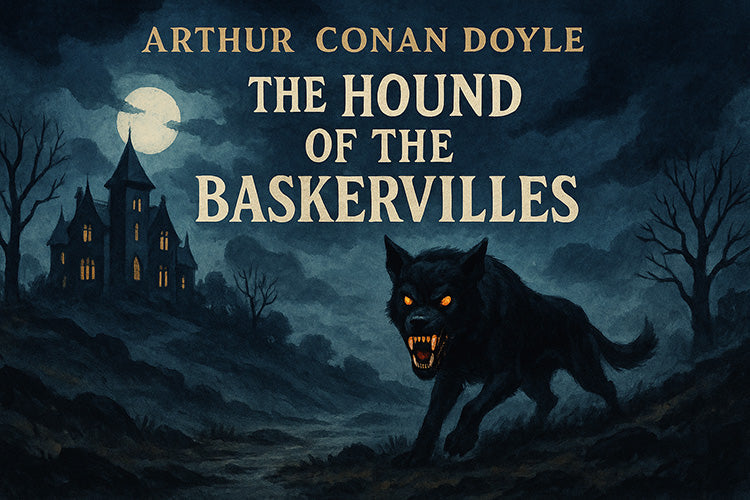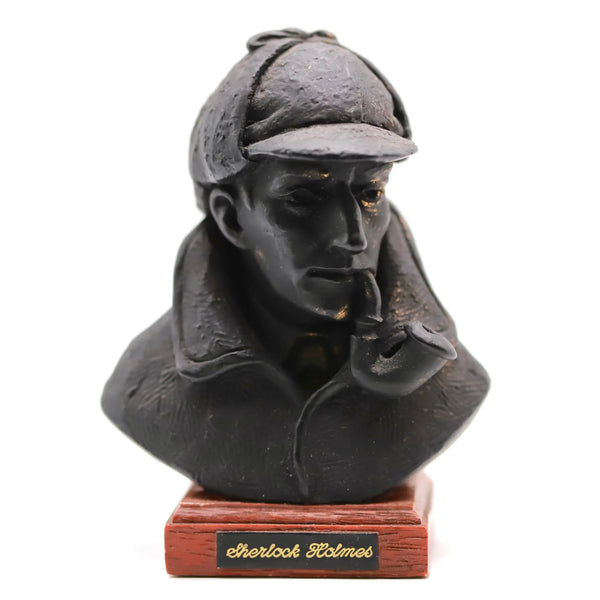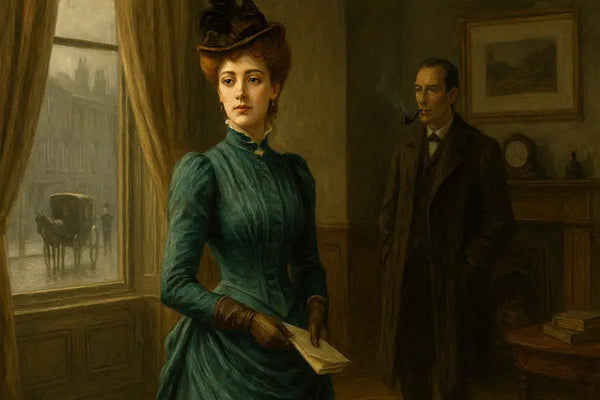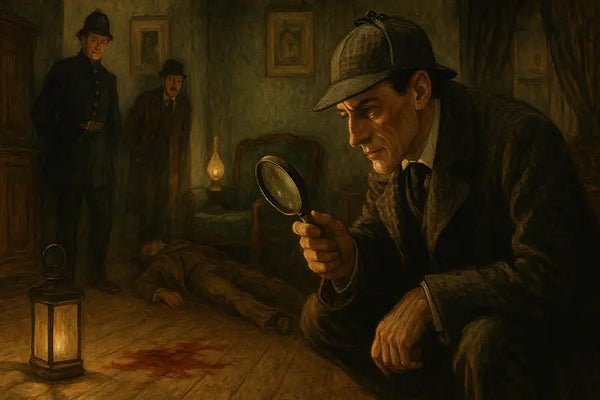Across the fog-shrouded expanse of Dartmoor, where ancient stone circles pierce the landscape like fingers of forgotten gods, there echoes a tale that has captivated readers for more than a century.
The Hound of the Baskervilles stands as perhaps the most celebrated entry in the Sherlock Holmes canon, a masterful fusion of detective fiction and gothic horror that showcases the brilliant mind behind the detective, Arthur Conan Doyle's legendary creation, at the height of his creative powers.
Published during a period when Arthur Conan Doyle had seemingly killed off his most famous creation, this novel represented both a resurrection and a revelation—foreshadowing the character's eventual revival and setting the stage for Holmes's return to continued adventures.
First appearing in Strand magazine, the story's serialization played a crucial role in popularizing both Holmes and the detective genre. Proving that Holmes’s investigative genius could illuminate even the darkest corners of supernatural terror whilst maintaining the rational framework that defined the character’s appeal, the novel further cemented Conan Doyle's literary significance and enduring authorship.
Summary
• Gothic Detective Fusion: The Hound of the Baskervilles masterfully combines traditional detective fiction with gothic horror elements, creating a supernatural atmosphere that Holmes must penetrate using rational deduction and scientific method. As a Sherlock Holmes novel, it stands out for its unique blend of genres and its canonical status within the Holmes series.
• Character Revival Strategy: Arthur Conan Doyle cleverly set this adventure before Holmes’s apparent death, allowing him to explore the character’s popularity whilst avoiding the complications of resurrection until later stories.
• Atmospheric Masterpiece: The novel showcases Conan Doyle’s finest descriptive writing, using the desolate Dartmoor landscape and the legendary curse to create an atmosphere of dread that pervades every chapter.
• Cultural Phenomenon: As the most adapted and referenced Holmes story, The Hound has transcended literature to become a cultural touchstone, inspiring countless films, television productions, and literary homages across multiple generations. It is one of the most frequently adapted original stories from the Holmes canon.
Historical Context and Publication Strategy
The period following “The Final Problem” in 1893 had seen an unprecedented public outcry for Sherlock Holmes’s return. Conan Doyle, who had grown weary of his creation and wished to pursue more serious literary endeavours, found himself facing constant pressure from readers, publishers, and even his own mother to resurrect the detective. The solution he devised was characteristically clever: rather than bringing Holmes back from the dead immediately, he would write a new adventure set before the Reichenbach Falls encounter.
The Strand Magazine’s serialisation of The Hound of the Baskervilles from August 1901 to April 1902 created a literary sensation that exceeded even the publication’s most optimistic projections. Circulation figures reached record heights, with newsstands selling out within hours of each monthly issue’s release. The public’s hunger for new Holmes adventures proved so intense that queues formed outside the magazine’s offices, whilst international cables carried plot developments to eager readers across the Empire.
Baskervilles led to a major revival of interest in Sherlock Holmes, significantly contributing to the character’s enduring legacy and cementing the novel’s status as a classic of detective fiction.
This commercial success fundamentally altered Conan Doyle’s perspective on his creation. The financial rewards were substantial enough to convince him that Holmes could coexist with his other literary ambitions, whilst the critical acclaim demonstrated that detective fiction could achieve genuine artistic merit when executed with sufficient skill and imagination.
The novel’s publication strategy also reflected changing attitudes towards popular literature. Unlike the dismissive reception often accorded to detective stories, The Hound of the Baskervilles received serious critical attention from literary reviewers who recognised its sophisticated blend of genres and its technical accomplishment. This acceptance helped legitimise detective fiction as a form worthy of serious consideration.
Contemporary reviews emphasised the novel’s atmospheric qualities and its successful integration of supernatural elements with rational detection. Critics particularly praised Conan Doyle’s descriptive writing and his ability to maintain suspense throughout the extended narrative whilst providing a satisfying logical resolution that respected both the detective fiction framework and the gothic tradition.
Plot Structure and Gothic Elements
The Hound of the Baskervilles employs a three-act structure that maximises both suspense and character development whilst seamlessly integrating gothic horror elements with detective methodology. This architectural approach creates mounting tension that culminates in revelations that satisfy both supernatural suggestion and rational explanation.
Act One establishes the legendary framework through Dr James Mortimer’s consultation at the detective’s famous lodgings. The reading of the Baskerville manuscript introduces the family curse, describing a hound of supernatural origin that haunts the Baskerville line. Sir Charles Baskerville’s mysterious death provides contemporary urgency, with local superstition fueling tales of a spectral hound roaming the moor.
Holmes’s initial analysis demonstrates his characteristic skepticism towards supernatural explanations whilst acknowledging the genuine danger facing Sir Henry Baskerville. Notably, the discovery of Sir Charles's footmarks near the scene of his death—unusually spaced and suggestive of flight—adds to the mystery and strengthens the legend of the supernatural hound.
The gothic elements emerge immediately through the legend of Sir Hugo Baskerville and his diabolical end. Conan Doyle draws upon centuries of British folklore surrounding supernatural hounds, crafting his own mythology centered on a diabolical hound that serves both atmospheric and plot functions. The curse operates on multiple levels: literal belief among local populations, psychological pressure on family members, and practical cover for criminal activity.
Act Two represents the novel’s most innovative structural element—Holmes’s apparent absence from the investigation. Watson’s solo journey to Dartmoor places him in the position of primary investigator whilst creating opportunities for extended atmospheric description and character development that would be impossible with Holmes dominating the narrative.
The Dartmoor sections showcase Conan Doyle’s mastery of gothic atmosphere. The desolate landscape, with its treacherous mires and ancient stone circles, creates a setting where supernatural events seem not only possible but inevitable. The author’s careful research during his own visits to Dartmoor provides authentic detail that grounds the fantastic elements in convincing geographical reality.
Act Three brings Holmes’s dramatic revelation of his hidden presence and the systematic dismantling of the supernatural explanation. The climactic encounter with the phosphorescent hound demonstrates how scientific analysis can explain apparently supernatural phenomena whilst maintaining the emotional impact of gothic horror. The resolution satisfies both detective fiction requirements for logical explanation and gothic tradition’s emphasis on atmospheric climax.
Character Analysis and Development
The Hound of the Baskervilles presents some of Conan Doyle’s most nuanced character development, with each major figure serving multiple narrative functions whilst maintaining psychological consistency and emotional depth.
Sir Henry Baskerville emerges as more than simply a potential victim, developing into a complex protagonist whose Canadian background provides both cultural contrast and personal resilience. His initial skepticism about the family curse gradually transforms into genuine fear as evidence accumulates, creating a character arc that mirrors the reader’s own evolving understanding of events. Sir Henry’s determination to uncover the truth and his actions in facing the dangers on the moor highlight his resolve and bravery.
Sir Henry’s romantic attraction to Beryl Stapleton adds emotional stakes that extend beyond mere survival, whilst his determination to claim his inheritance despite supernatural threats demonstrates admirable courage. His character represents the collision between New World pragmatism and Old World superstition, embodying themes of cultural change and traditional persistence.
Dr James Mortimer functions as both exposition provider and scientific counterpoint to supernatural belief. His medical training creates internal conflict between rational analysis and folkloric acceptance, reflecting Victorian society’s broader tensions between scientific progress and traditional belief systems. Mortimer’s genuine concern for the Baskerville family humanises what could have been merely functional character.
Jack Stapleton represents one of Conan Doyle’s most sophisticated villains, whose naturalist expertise provides both criminal methodology and credible local knowledge. His true identity as Rodger Baskerville creates genealogical legitimacy for his inheritance claim whilst his scientific background enables the technical aspects of his deception.
Stapleton’s psychological profile reveals calculating intelligence combined with patient long-term planning. His ability to maintain his false identity whilst systematically eliminating Baskerville heirs demonstrates the criminal potential of intellectual gifts divorced from moral constraints. The character also embodies fears about scientific knowledge being used for destructive purposes.
Beryl Stapleton transcends the typical gothic heroine role through her active attempts to protect Sir Henry despite personal danger. As sister Beryl, her familial connection to Stapleton is central to the plot, and her captivity within Stapleton’s schemes creates genuine pathos whilst her warnings demonstrate moral courage that complicates simple victim-villain dynamics.
Watson’s Enhanced Role provides the novel’s most significant character development. John Watson, as Holmes’s trusted companion, is often addressed by Holmes as "Dear Watson," emphasizing their close partnership. The companion Dr’s independent investigation of Dartmoor events showcases capabilities that are often overshadowed by Holmes’s brilliance.
Watson’s methodical approach to gathering evidence and his detailed reporting demonstrate professional competence whilst his emotional responses to the supernatural atmosphere humanise the investigation. Holmes assigns Watson as Sir Henry's bodyguard, entrusting him with the critical task of protecting Sir Henry from potential threats on the moor.
The novel allows Watson to function as protagonist for extended periods, creating opportunities for character growth that would be impossible under Holmes’s constant supervision. His moments of genuine detective insight and his courage in confronting apparent supernatural dangers establish him as more than merely Holmes’s chronicler.
The Hound as Gothic Symbol
The supernatural hound operates on multiple symbolic levels that enrich the narrative beyond its function as mere plot device. Drawing upon centuries of British folklore surrounding spectral dogs, Conan Doyle creates a monster that embodies both psychological terror and social commentary whilst maintaining sufficient ambiguity to support both supernatural and rational interpretations.
The demonic, vicious hound with dripping jaws represents the persistence of ancestral guilt across generations, with Sir Hugo Baskerville’s historical crimes manifesting as ongoing family punishment. This concept reflects Victorian anxieties about heredity and moral inheritance, suggesting that sins committed by previous generations continue to affect their descendants through both psychological and practical mechanisms.
The hell hound tradition in gothic literature typically serves as divine retribution for moral transgression, yet Conan Doyle complicates this interpretation by revealing the creature’s artificial nature. The phosphorescent compound that creates the hound’s supernatural appearance transforms divine punishment into human manipulation, suggesting that many apparently supernatural phenomena result from deliberate deception rather than otherworldly intervention.
The gigantic hound also functions as symbol of repressed Victorian fears about the natural world’s untamed power. Its massive size and predatory nature represent forces that civilisation cannot fully control or understand, whilst its nocturnal appearances suggest threats that emerge from darkness both literal and metaphorical.
Take a closer look at this authentic 1902 first edition for sale!
Dartmoor Setting and Atmosphere
Conan Doyle’s treatment of Dartmoor transcends mere geographical description to create a landscape that functions as narrative participant rather than passive backdrop. His careful research during personal visits to the region provides authentic detail that grounds the fantastic elements whilst creating atmosphere that supports both supernatural suggestion and practical concealment.
The desolate moorland with its treacherous bogs and ancient stone circles creates natural isolation that makes mysterious events seem both possible and unobservable. Grimpen Mire specifically functions as symbol of hidden dangers that lurk beneath apparently solid surfaces, reflecting the novel’s broader themes about deceptive appearances and concealed threats.
Archaeological elements scattered across the landscape—prehistoric settlements, stone circles, and ancient burial sites—create temporal depth that suggests the persistence of past influences on present events. These features support the gothic tradition’s emphasis on historical continuity whilst providing practical concealment for contemporary criminal activity.
Weather patterns and natural phenomena enhance the atmospheric effects through fog, wind, and the distinctive acoustic properties of moorland terrain. The famous scene of the hound’s howling demonstrates how natural sound effects can create supernatural suggestions whilst maintaining scientific explanation possibilities.
The isolation of the Baskerville estate, with Baskerville Hall at its heart, and its relationship to the surrounding landscape creates psychological pressure that affects both characters and readers. The imposing hall door, heavy and ancient, stands as a symbol of the estate’s long, troubled history and the family’s connection to the legend of the hound. The building’s position between civilised comfort and wild moorland reflects the novel’s broader tension between rational analysis and primitive fear, whilst its architectural features provide both gothic atmosphere and practical plot requirements.
Scientific Detection versus Supernatural Terror
The Hound of the Baskervilles achieves its enduring success through the sophisticated balance between rational investigation and supernatural suggestion, with the great detective Sherlock Holmes’s scientific methodology serving as counterpoint to gothic atmosphere rather than simply dismissing it.
Detective Sherlock Holmes’s approach to apparently supernatural events demonstrates the systematic reasoning that defines his method, applying empirical observation and logical analysis to phenomena that appear to transcend natural explanation. His examination of footprints, analysis of physical evidence, and psychological profiling of suspects maintain detective fiction’s rational framework whilst respecting the emotional power of supernatural terror.
The chemical analysis of the phosphorescent compound that creates the hound’s ghostly appearance represents Victorian confidence in scientific explanation for apparently mysterious phenomena. This approach reflects contemporary optimism about science’s ability to illuminate superstition whilst acknowledging that human manipulation can create effects indistinguishable from genuine supernatural manifestation.
Watson’s role in documenting empirical observations provides crucial evidence gathering that supports both supernatural and rational interpretations until Holmes’s final revelation resolves the ambiguity. His detailed reports demonstrate the importance of systematic observation in detective work whilst maintaining narrative suspense about the ultimate explanation.
The novel’s treatment of local folklore and superstition shows respectful acknowledgment of traditional belief systems whilst asserting reason’s ultimate authority. This approach reflects Victorian attitudes towards rural culture and scientific progress without completely dismissing the psychological reality of supernatural fear, further highlighting the legendary status of the great detective.
Themes and Social Commentary
The Hound of the Baskervilles operates as social commentary on multiple levels, using its gothic detective framework to explore Victorian anxieties about heredity, class, science, and cultural change whilst maintaining focus on entertainment and atmospheric effect. As a work of classic literature, the novel’s enduring influence is evident in its sophisticated exploration of these themes and its lasting impact on detective fiction and popular culture.
Hereditary guilt and ancestral sin provide the novel’s moral framework, with Sir Hugo Baskerville’s historical crimes creating consequences that affect subsequent generations. This theme reflects Victorian concerns about biological and moral inheritance, suggesting that families bear responsibility for their ancestors’ actions whilst questioning whether such responsibility should extend indefinitely.
Class distinctions between urban sophistication and rural tradition create cultural tension that affects character relationships and plot development. Holmes and Watson represent metropolitan scientific rationality whilst local characters embody traditional belief systems and folkloric knowledge, with the resolution favouring rational analysis whilst acknowledging the practical value of local wisdom.
The criminal use of scientific knowledge for personal gain reflects contemporary anxieties about technological progress and its potential for abuse. Stapleton’s naturalist expertise enables his deception whilst his understanding of local geography provides tactical advantages, suggesting that education and scientific training can serve criminal as well as beneficial purposes.
Women’s roles and social constraints receive significant attention through Beryl Stapleton’s character, whose captivity within her brother’s schemes reflects broader limitations on female agency whilst her attempts to protect Sir Henry demonstrate moral courage that transcends conventional gender expectations.
Literary Techniques and Writing Style
Conan Doyle’s prose style reaches its peak effectiveness in The Hound of the Baskervilles, demonstrating masterful control of atmospheric description, character development, and narrative pacing that creates lasting emotional impact whilst maintaining logical coherence. Compared to the Holmes short stories, the novel employs similar techniques of suspense and character-driven narrative, but expands them over a longer form, allowing for deeper atmospheric immersion and more intricate plot development.
Atmospheric writing techniques include extensive use of weather and landscape to create mood, with fog, wind, and natural sounds enhancing supernatural suggestions whilst providing rational explanation possibilities. The author’s careful attention to sensory detail creates immersive experiences that engage readers emotionally whilst supporting plot requirements.
The narrative structure builds suspense through delayed revelation and strategic information withholding, with Holmes’s apparent absence creating opportunities for extended atmospheric development and character growth. Watson’s enhanced narrative voice provides detailed observations that maintain reader engagement whilst supporting the detective fiction framework.
Dialogue reveals character whilst advancing plot, with each major figure displaying distinctive speech patterns that reflect educational background, regional origin, and psychological state. The conversations between Holmes and Watson demonstrate their established relationship whilst showing professional development, whilst interactions with local characters provide cultural contrast and folkloric information.
Integration of historical legend with contemporary mystery creates temporal depth that supports both gothic tradition and detective innovation. The Baskerville manuscript provides authentic period detail whilst serving specific plot functions, demonstrating how historical research can enhance fictional effectiveness.
Adaptations and Cultural Impact
The Hound of the Baskervilles has inspired more adaptations than any other Holmes story, with each interpretation reflecting its era’s technological capabilities, cultural attitudes, and artistic conventions whilst maintaining focus on the story’s essential elements. Numerous film versions and television adaptations have contributed to the story’s enduring legacy, each bringing unique perspectives to the classic tale.
Early stage adaptations emphasised spectacle and visual effects, with elaborate sets recreating Dartmoor’s atmospheric landscape and mechanical devices creating the supernatural hound’s appearance. These productions established performance traditions that influenced subsequent interpretations whilst demonstrating the story’s theatrical potential.
Basil Rathbone and Nigel Bruce’s 1939 film adaptation became the definitive cinematic interpretation for several generations, establishing visual and performance standards that influenced later productions. The film’s atmospheric cinematography and effective use of sound design demonstrated how cinematic techniques could enhance the story’s gothic elements whilst maintaining detective fiction coherence.
Peter Cushing’s portrayal of Holmes in Hammer Horror’s 1959 film version emphasised the story’s supernatural elements through gothic visual style and heightened atmosphere, creating a version that influenced horror film conventions whilst demonstrating the story’s genre flexibility.
Jeremy Brett’s Granada Television production provided perhaps the most faithful adaptation, with extensive location filming on Dartmoor and careful attention to period detail creating authentic Victorian atmosphere whilst showcasing Brett’s definitive Holmes portrayal.
Benedict Cumberbatch’s modern “Hounds of Baskerville” episode in the TV series Sherlock updated the story for contemporary audiences whilst maintaining essential plot elements, demonstrating the narrative’s adaptability to different time periods and technological contexts.
International adaptations have reflected diverse cultural approaches to gothic horror and detective fiction, with Russian, Japanese, and German versions offering unique perspectives on the story’s themes whilst maintaining focus on the central mystery.
The story’s influence on subsequent detective fiction extends beyond direct adaptations to encompass structural innovations and atmospheric techniques that became standard elements of the genre. The combination of supernatural suggestion with rational explanation provided a template for numerous later works, whilst the use of landscape as narrative participant influenced environmental approaches to mystery writing.
Tourism impact on Dartmoor and related locations demonstrates the story’s continuing cultural relevance, with visitors seeking authentic experiences of the novel’s atmospheric settings whilst contributing to local economic development.
The Novel's Influence on Detective Fiction
The Hound of the Baskervilles established crucial precedents for atmospheric detective fiction that continue to influence contemporary mystery writing, demonstrating how supernatural elements can enhance rather than undermine rational investigation whilst creating lasting emotional impact.
The template for gothic detective combinations shows how traditional genre boundaries can be crossed successfully when handled with sufficient skill and imagination. The novel's approach to balancing competing generic requirements provided a model for numerous subsequent works that attempt similar atmospheric effects.
The use of landscape as narrative element demonstrated how environmental description can serve plot functions whilst creating atmospheric effects, influencing how later writers approach setting development and mood creation.
The novel's handling of supernatural elements within detective fiction frameworks showed how apparently contradictory genre conventions can be reconciled through careful plotting and logical resolution, providing guidance for writers attempting similar combinations.
Academic analysis and scholarly interpretation have recognised the novel's literary merit whilst acknowledging its entertainment value, helping to establish detective fiction's legitimacy as serious literature worthy of critical attention.
Position in the Holmes Canon
The Hound of the Baskervilles occupies a unique position within the complete Sherlock Holmes oeuvre, functioning simultaneously as standalone masterpiece and integral component of the broader character development that defines the series.
Its relationship to the other Holmes novels demonstrates progression in both writing technique and character understanding, with Conan Doyle’s growing confidence evident in the sophisticated atmospheric effects and complex character development that distinguish this work from earlier efforts.
The novel’s function as bridge between Holmes’s “death” and resurrection provides crucial continuity whilst allowing exploration of the character’s popularity without immediate commitment to permanent revival. This strategic position enables both nostalgic satisfaction and future possibility. Notably, after the events of The Hound of the Baskervilles, Holmes's story continues in 'The Adventure of the Empty House,' where his dramatic return and investigation of an empty house play a key role in the suspense and mystery, further developing the continuity of the Holmes canon.
Its status as the most famous Holmes adventure reflects successful combination of accessibility and sophistication, with atmospheric effects and character development appealing to broad audiences whilst maintaining intellectual complexity that rewards detailed analysis.
Connection to the short story collections shows how the novel form allows extended character and atmospheric development that complements the concentrated effectiveness of shorter works, demonstrating the different possibilities available within the detective fiction framework.
A rare 1902 George Newnes edition, of the Hound of Baskervilles for Sale!
Conclusion
The Hound of the Baskervilles stands as Arthur Conan Doyle’s greatest achievement within the detective fiction genre and is widely regarded as a pinnacle of the Sherlock Holmes series. The novel successfully fuses rational investigation with supernatural atmosphere whilst maintaining the character consistency and logical framework that define Holmes’s enduring appeal. Its sophisticated balance of competing genre requirements demonstrates how popular fiction can achieve genuine artistic merit without sacrificing entertainment value.
The novel’s enduring popularity reflects its successful integration of universal themes—guilt, justice, fear, and redemption—with specific period concerns about science, tradition, and cultural change. Central to the plot is the importance of the Sir Charles heir, as the fate of Sir Henry Baskerville becomes entwined with the family legend and the mysterious circumstances surrounding the deaths of previous heirs. Its atmospheric effects transcend mere local colour to create lasting emotional impact that enhances rather than competes with the detective plot’s intellectual satisfaction.
For contemporary readers, The Hound of the Baskervilles offers both historical insight into Victorian anxieties and timeless exploration of human nature’s complexity. Its treatment of supernatural fear and rational analysis remains relevant to modern audiences confronting their own tensions between tradition and progress, belief and skepticism.
Within the broader context of English literature, the novel represents detective fiction’s successful claim to serious artistic consideration whilst maintaining the accessibility and entertainment value that define popular culture’s best achievements. Its influence continues to shape how mystery writers approach atmospheric effects and character development, ensuring its lasting relevance to both academic study and popular enjoyment.
Frequently Asked Questions
What is the plot of The Hound of the Baskervilles by Arthur Conan Doyle?
The Hound of the Baskervilles follows Dr Mortimer’s consultation with Holmes about the mysterious death of Sir Charles Baskerville and the legendary family curse involving a supernatural hound. Sir Charles was known for his nightly walks at a specific hour—often referred to as "o'clock Barrymore"—with Barrymore, the butler, noting the suspicious circumstances and timing of his last walk. When Sir Henry Baskerville arrives from Canada to claim his inheritance, Holmes sends Watson to protect him on Dartmoor whilst secretly conducting his own investigation. Holmes and Watson discover that Laura Lyons, whose initials 'L. L.' appear in a mysterious letter to Sir Charles, is a key figure with a troubled background and connections to Frankland and Stapleton, making her central to the investigation into Sir Charles's death. The story reveals how Jack Stapleton, the true Rodger Baskerville, uses a real dog enhanced with phosphorescent paint to simulate the legendary hound whilst eliminating family members to claim the estate.
Why is The Hound of the Baskervilles considered the best Sherlock Holmes story?
The Hound of the Baskervilles is widely regarded as the finest Holmes story because it perfectly balances detective fiction with gothic horror, creating atmospheric tension whilst maintaining logical resolution. The novel showcases Conan Doyle's best descriptive writing, complex character development, and sophisticated plot structure. Its combination of supernatural suggestion with rational explanation, enhanced by the atmospheric Dartmoor setting, creates lasting emotional impact that transcends typical detective fiction whilst demonstrating Holmes's methods at their most effective.
How does The Hound of the Baskervilles combine detective fiction with gothic horror?
The novel integrates detective and gothic elements through its dual approach to the supernatural hound legend, presenting evidence that supports both supernatural and rational explanations until Holmes's final revelation. Gothic atmosphere emerges through the desolate Dartmoor setting, the family curse mythology, and supernatural suggestions, whilst detective elements include systematic investigation, physical evidence analysis, and logical deduction. The story maintains gothic emotional impact whilst providing detective fiction's rational resolution.
What role does Dr Watson play in The Hound of the Baskervilles?
Watson serves as primary investigator for most of the novel, conducting independent detective work on Dartmoor whilst Holmes secretly observes events. This enhanced role allows significant character development, showcasing Watson's observational skills, courage, and analytical abilities beyond his usual function as Holmes's chronicler. His detailed reports provide crucial evidence whilst his emotional responses to the supernatural atmosphere humanise the investigation and create reader identification with the mystery's psychological effects.
Is the hound in The Hound of the Baskervilles really supernatural?
The hound is ultimately revealed to be a real dog—a large mastiff-bloodhound cross—enhanced with phosphorescent paint to create supernatural appearance. Jack Stapleton uses this creature to simulate the legendary family curse whilst systematically eliminating Baskerville heirs. Holmes's investigation demonstrates how scientific analysis can explain apparently supernatural phenomena, though the novel maintains respect for the psychological reality of supernatural fear and its effects on human behaviour.
Where was The Hound of the Baskervilles filmed and set?
The novel is set on Dartmoor in Devon, Southwest England, where Conan Doyle conducted research visits to ensure geographical accuracy. The story centres around the fictional Baskerville Hall and nearby Grimpen Mire, though real Dartmoor locations inspired these settings. Most film and television adaptations have used actual Dartmoor locations for exterior filming, with various country houses serving as Baskerville Hall. The authentic moorland landscape provides the atmospheric setting essential to the story's gothic effects.
Read more about this 1902 George Newnes edition, of the Hound of Baskervilles!














































